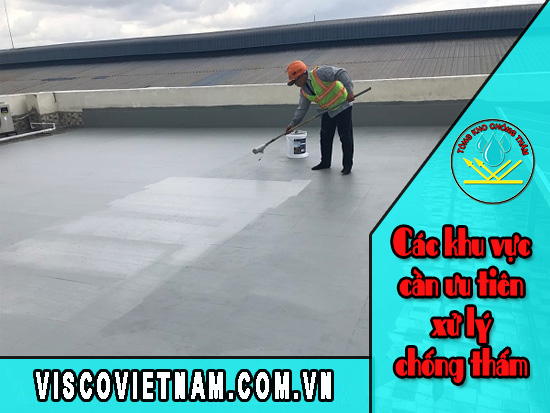During construction, in addition to careful execution and ensuring the quality of various project components, certain areas prone to moisture need to be prioritized for waterproofing.
These areas are often directly exposed to external environments and face harsh weather conditions, from intense sunlight to heavy rainstorms, or are in constant contact with water. Proper waterproofing in these areas not only ensures the durability of the building but also helps maintain long-term aesthetics.
Every construction project is made up of various tightly connected components that form a complete whole. However, aside from well-protected sections, there are sensitive areas that are directly impacted by extreme weather and humidity. If waterproofing is not thoroughly addressed, these areas can deteriorate quickly, severely affecting the structure and quality of the entire building.

Below are the most sensitive areas prone to water infiltration, which should be prioritized for waterproofing in construction projects:
Ceilings, rooftops and balconies are exposed directly to all weather conditions such as strong sunlight, heavy rains, and frequent temperature changes. These fluctuations cause materials to expand and contract, leading to cracks and water infiltration. To prevent damage, waterproofing should be done right from the construction phase. If this step is skipped, repairing water leakage issues later will be more complicated and expensive.
Although not directly exposed to outdoor weather, bathroom floors frequently encounter large amounts of water from daily activities such as bathing and cleaning. Continuous moisture creates conditions for water infiltration, damaging the floor and related structures. In residential or apartment buildings, especially those with multiple bathrooms, comprehensive waterproofing is crucial to ensure safety and avoid unwanted complications.
|
Common waterproofing materials for ceilings, rooftops and balconies Selecting the right waterproofing materials is a key factor in determining the quality and durability of a building, especially in areas like ceilings, rooftops, and balconies, which are significantly affected by weather. Below are some common waterproofing materials: 1. Waterproof Paint Waterproof paint is a popular choice due to its easy application and flexibility. The main components of waterproof paint are typically polymers, rubber, and cement, which create a protective layer on the surface to prevent water penetration. Waterproof paint can be effectively used on various areas like ceilings, rooftops, and balconies, but to achieve the best results, the surface must be thoroughly cleaned and treated before application. 2. Bitumen Waterproof Membrane Bitumen waterproof membranes are favored due to their composition of bitumen combined with fiberglass or polyester fibers. This material provides excellent waterproofing, suitable for surfaces that frequently come into contact with water and sunlight, such as rooftops and balconies. Bitumen membranes are often applied by heating them to bond with the surface, creating a strong and durable waterproof layer. 3. HDPE Waterproof Membrane HDPE waterproof membranes are known for their high durability and resistance to weather impacts, particularly UV rays. HDPE membranes have a long lifespan, are easy to maintain, and are suitable for use on ceilings, rooftops, and balconies. With their flexibility and superior waterproofing capabilities, HDPE membranes are commonly used in areas requiring long-term protection against water and moisture. 4. Polyurethane (PU) Waterproof Layer Polyurethane is a highly elastic waterproof material, commonly applied to structures made of concrete or wood. The PU waterproof layer has excellent water resistance, can withstand high temperatures, and resists minor surface movements without cracking. This makes it an ideal solution for rooftop or balcony areas where material expansion occurs due to weather conditions. 5. Waterproof Concrete Concrete can be enhanced with waterproofing additives during the manufacturing process. These additives help increase the watertightness of the concrete, preventing water from seeping through. After construction, the concrete surface can be further coated with a waterproof layer to provide additional protection. This is a popular solution for projects that require a high level of waterproofing and structural durability. In summary, the choice of waterproofing materials should be based on the characteristics of the construction area and the specific requirements of the project. Depending on each location and environmental conditions, materials such as waterproof paint, waterproof membranes, PVC membranes, PU layers, or waterproof concrete can offer effective protection. |
Wall areas that are directly exposed to the external environment, such as adjacent walls, boundary walls, and baseboards, frequently suffer from the effects of hot and humid climates. Rainwater can accumulate on the surface or seep up from the ground, causing water infiltration and damaging the wall structure. This not only reduces the aesthetics but also affects the building’s durability. Therefore, waterproofing for walls is essential to fully protect the house.
Areas with water pipes, including drainage and water supply systems, are also sensitive to the risk of water infiltration. Leaks from pipes can cause prolonged dampness, putting pressure on surrounding building materials and leading to damage. Therefore, during installation, special attention must be given to waterproofing the areas around pipes to avoid future issues.
Overall, waterproofing these sensitive areas is a critical step to maintaining the durability and aesthetics of a building. The waterproofing process should be carried out according to proper procedures and with high-quality materials to ensure long-term protection for the construction.
The above information outlines the areas that should be prioritized for waterproofing during construction. If you need more information or would like to receive advice on effective waterproofing solutions, please contact us through the website VISCOVIETNAM.COM.VN. We are always ready to assist you in resolving any water infiltration issues, ensuring the best durability and quality for your project.